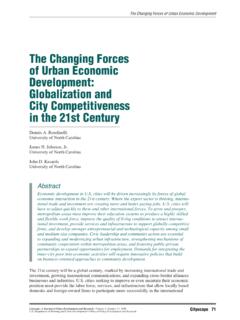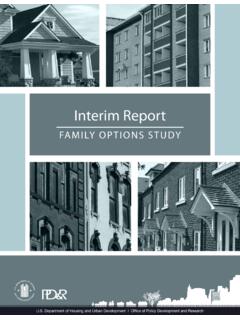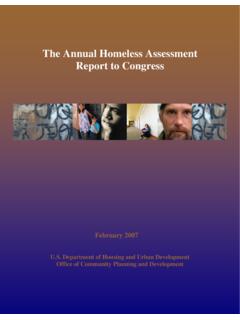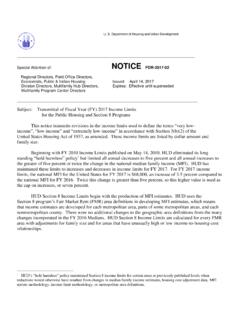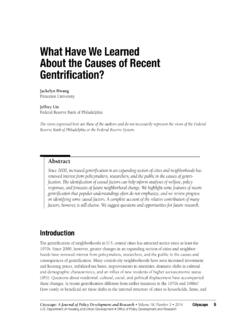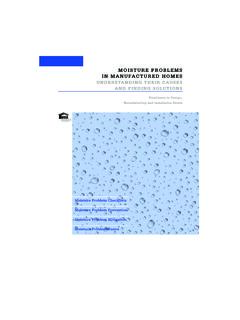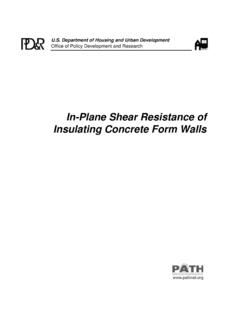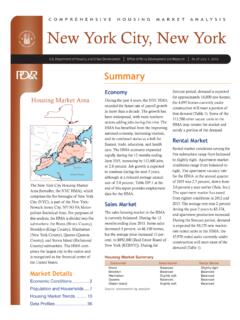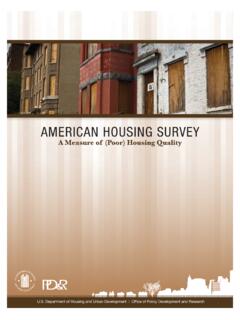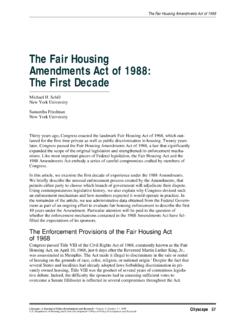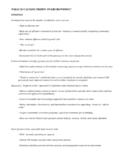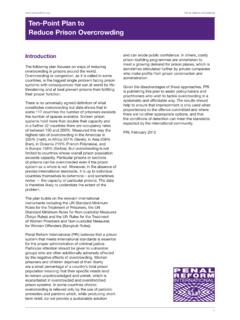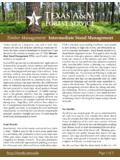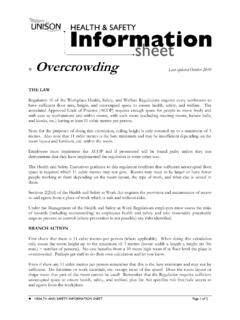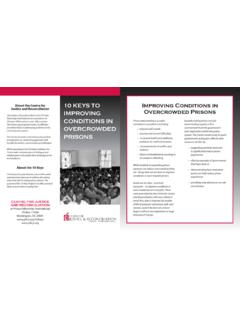Transcription of Measuring Overcrowding in Housing - HUD User
1 Measuring Overcrowding in Housing Prepared for: Department of Housing and Urban Development Office of Policy Development and Research Prepared by: Econometrica, Inc. Bethesda, Maryland Kevin S. Blake Rebecca L. Kellerson Aleksandra Simic ICF International Fairfax, Virginia Contract No. GS-10F-0269K. Task E. Order No. CHI-T0002. Project No. 017-002. September 2007. Table of Contents 1. 1. Definitions of Overcrowding .. 2. 2. Overcrowding Measures .. 5. Persons-Per-Room (PPR).. 5. Persons-Per-Bedroom (PPB) .. 6. Unit Square Footage-Per-Person (USFPP).
2 8. Persons-Per-Room (PPR) by Unit Square Footage-Per-Person (USFPP) .. 10. 3. Demographic Cross-tabulations .. 12. Persons-Per-Room (PPR).. 12. Demographics for Persons-Per-Bedroom (PPB) and Unit Square Footage-Per-Person (USFPP) .. 17. 4. 23. APPENDIX A: Literature Review .. A-1. APPENDIX B: Home B-1. ii List of Figures Figure 1: Overcrowding Standards for PPR and PPB Included in the UK ODPM Report 3. Figure 2: Traditional and Alternate Definitions of Overcrowding .4. Figure 3: Persons-Per-Room, Using AHS National Data ..6. Figure 4: Persons-Per-Bedroom, Using AHS National Data.
3 7. Figure 5: Square Footage-Per-Person, Using AHS National Data .9. Figure 6a: PPR by USFPP, 2005 ..10. Figure 6b: PPR by USFPP, 1985 ..10. Figure 7: Persons-Per-Room (PPR) by Unit Square Footage-Per-Person (USFPP), Using AHS. National Data .11. Figure 8: Persons-Per-Room, by Ethnicity and Race ..13. Figure 9: Person-Per-Room, by Income ..14. Figure 10: Person-Per-Room, by Tenure ..14. Figure 11: Persons-Per-Room, by Region 15. Figure 12: Persons-Per-Room, by Metropolitan Area ..16. Figure 13: Persons-Per-Room by Citizenship ..16. Figure 14: Overcrowding by Ethnicity and Race.
4 18. Figure 15: Overcrowding by Income 19. Figure 16: Overcrowding by Tenure .20. Figure 17: Overcrowding by Region 20. Figure 18: Overcrowding by Metropolitan Area ..21. iii List of Figures (Cont.). Figure 19: Overcrowding by Citizenship Status ..22. Figure 20: Comparison of the PPR and USFPP Measures ..24. Figure B1: Distribution of Square Footage-Per-Person, Using 2005 AHS National Data ..B-1. iv Measuring Overcrowding in Housing Introduction The Department of Housing and Urban Development (HUD) funds the Census Bureau to conduct the American Housing Survey (AHS), a biennial record of the physical characteristics, quality, and condition of the nation's Housing stock and of the characteristics of the households in occupied Housing units.
5 Separate AHS surveys provide periodic examinations of the Housing stock in 21 major metropolitan areas. In 2006, HUD contracted with Econometrica, Inc. and ICF International to support the production and use of the AHS. As part of that contract, HUD commissioned a study of Overcrowding and how alternative definitions could be quantified using the AHS. Specifically, HUD asked the Econometrica team to explore alternative ways to define Overcrowding , and to base those alternatives on what is known about the consequences of Overcrowding .
6 We conducted this research in two parts. The first being a literature review focused on the consequences of Overcrowding . We should note that HUD directed us to focus on the consequences of Overcrowding for occupants and to not consider the consequences for neighbors. Specifically HUD advised us to ignore the issues of large immigrant households or households composed of many college students that are frequently discussed in newspaper articles or the popular press. After performing an extensive literature review, it is clear that there are only a few accepted definitions of Overcrowding .
7 And of these definitions, persons-per-room (PPR) is the measure most prevalent in the literature. In this report, we utilized multiple definitions in conjunction with the AHS National data to demonstrate how Overcrowding changed over time from 1985. until 2005. Our report is organized as follows: Section 1 presents alternative definitions of Overcrowding as well as key findings from our literature review. We explore both the generally accepted measure of persons-per- room as well as other alternate definitions. Section 2 presents a summary of the different measures that were applied to the AHS and what these measures demonstrated at a high level.
8 Section 3 extends the analysis in Section 2 by examining how Overcrowding affects various segments of the population using each of the Overcrowding measures. Section 4 presents our conclusions and potential next steps. 1. Measuring Overcrowding in Housing 1. Definitions of Overcrowding The most common measure of Overcrowding is persons-per-room in a dwelling unit. Prior to starting our research, we understood that other popular definitions of Overcrowding included: the total number of persons in a unit, regardless of unit size; the ratio of persons to floor space in square feet; and the person-to-size ratio adjusted for household composition, structure type, location, or lot size.
9 We were interested in exploring as many of these measures as possible during our literature review to identify the best measures to capture Overcrowding and the most appropriate standards. We began our research using the extensive bibliography of a relevant research paper, The Impact of Homeownership on Child Outcomes (Haurin, Haurin, Parcel, 1999), web searches of Google and KnowledgePlex, and recommendations of colleagues well-versed in a variety of connected subject matters. Our preliminary research led us to journals ranging from Child Development to Land Economics.
10 After reviewing the articles in these journals, and finding less than relevant material, we met with HUD to discuss how to re-focus our search. The agreed upon approach was to examine the prevalence of communicable diseases in overcrowded environments and the effects they have on a child's growth and development. And of these, we focused primarily on Meningitis, Hepatitis, and Tuberculosis. These three disease vectors were in addition to looking at the effects of second-hand smoke and household hazards in overcrowded homes. Our shift in focus was fortunate as we found a report commissioned by the United Kingdom Office of the Deputy Prime Minster in 2004 that answered the key questions posed in this research task.
